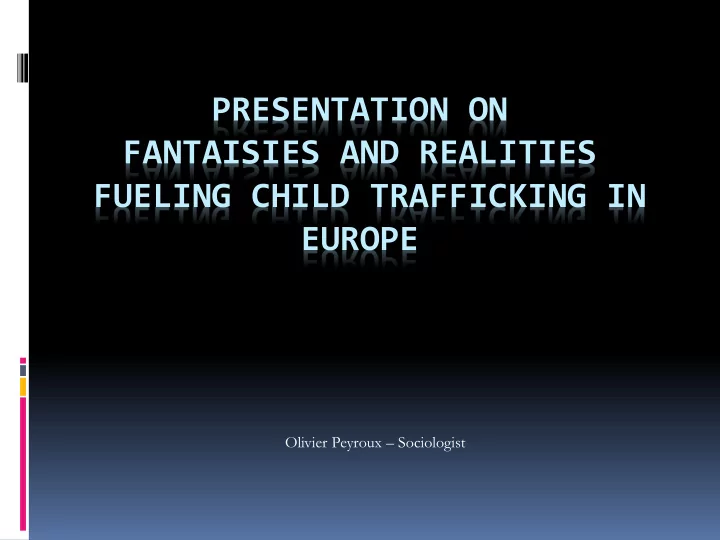

PRESENTATION ON FANTAISIES AND REALITIES FUELING CHILD TRAFFICKING IN EUROPE Olivier Peyroux – Sociologist
Indicators of exploitation and child trafficking Juvenile delinquents are not aware of being used or exploited, most of the time they believe to be part of a family or peer business. They trust their exploiters. Speechs are stereotyped. The amount of money stolen doesn’t fit the life and appearence of the minor (about 12000 euros/month). Family doesn’t show even when the minor is jailed. The offences all have very similar process as if they were rehearsed.
Is it something new ?
Types of trafficking a. family whose economic strategies have drifted into exploitation of their own children (begging, Refugees, etc.) b. criminal organisations without strong community ties that use violence to coerce the children (sexual exploitation / smugglers Albanian case) c. criminal or family organisations that use violence and subverted community rules to coerce the children;
Structuring & Recruitment Families including in the network by a debt bondage system or “taxes” (Tandarei) Exploited by the diaspora (Algerians, Vietnamese) No hierarchy structure, opportunistic alliances (groups from Serbia, Romania) Daughters in law are the most exploited 5
General overview on the criminal groups using minors A precise geographical origin limited to a few neighbourhoods or to a narrow number of towns A family and community basis used for the psychological hold/influence of the victims, A modus operandi specific to each group (theft by the Automated Teller Machines or ATMs, theft of mobile phones, pick pocketing using fake petitions etc.), Ramifications in different Western European countries fostering children movements or transfers. 6
Focus on 1 children group who are forced to commit crimes in France, Spain, Italy, Germany, Norway Exploited in Paris from 2009 and in Spain and Italy from 2005 From Constanta and Braila(Romania) Around 70 children boys and girls, 10 to 16 years old Pick-pocketing, mobile phones theft 7
Twisted codes around marriage customary The profitability of the young girl is a preponderant criterion in the choice of the bride The dowry loses its symbolical value and becomes a “price of the bride”, sometimes as high as 10,000 euro The family in law converts symbolically the money paid at the marriage ceremony into a debt that must pay back through stealing activities. If a girl is promised to an in-law family, and the word of her father is not kept, the Stabor (traditional court) meets and important sums of money must be paid as compensation by the family of the young girl. 8
P RESTIGE VS VICTIMS Present in the different forms of exploitation (sexual exploitation, forced criminality, drugs dealing, etc.) Migration is considering as the only option to escape from a social condition A step for a social recognition
Factors determining minors to ask for protection Mistreatment, Low level of personal benefits, No possibility to grow-up their children; most of the time, the child is entrusted to relatives A high quantity of money demanded from them The absence of perspective within the organisation. 10
I NITIATIVES TO PROTECT CHILD VICTIMS IN E UROPE Victim identification system in the UK is disconnected from the opening of a police investigation - improving process of indentification (602 minors 2013) - forms of child exploitation covered are not limited to sexual exploitation - Changing our view on THB (1st nationality are britain) UE database for victims of THB Facilitating access to the status of victim (Ity art.13 and art.18) Simplifying the referrals procedure, innovative responses and specialised centres, (NL) Guardianship (Bl) Educational approach and multidisciplinary work
Protection Not only to protect but also to find a way for a social recognation 12
Olivier Peyroux Sociologist olivier.peyroux@gmail.com
Recommend
More recommend